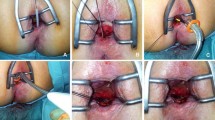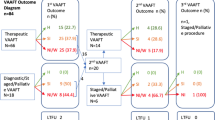Abstract
Background and aims
It was the aim of this prospective study to analyze the efficacy of the Cook Surgisis® AFP™ anal fistula plug (AFP) for the closure of cryptoglandular and Crohn’s disease-associated transsphincteric anorectal fistulas.
Materials and methods
All patients with transsphincteric anorectal fistulas who underwent a surgical procedure using the AFP were prospectively enrolled in this study. Inclusion criteria included transsphincteric, single-tract fistulas. Patients’ demographics, fistula etiology, surgical variables, continence (Cleveland Clinic Florida incontinence score), quality of life (fecal incontinence quality of life), and success rates were prospectively recorded. Surgery was performed in a standardized technique including irrigation of the fistula tract, placement, and internal fixation of the Cook Surgisis® AFP™ anal fistula plug. No flap or excision of the fistula tract was performed. Success was defined as closure of both internal and external openings, absence of drainage without further intervention, and absence of abscess formation. Follow-up information was derived from clinical examination 3, 6, 9, and 12 months postoperatively.
Results
Within 6 months (August 2006 to January 2007), a total of 19 AFPs were inserted in 19 patients (8 females, 11 males; mean age, 38 years). Out of 19 patients, 12 had cryptoglandular and 7 had Crohn’s associated transsphincteric fistulas. Three patients were smokers, one patient had methicillin-resistant Staphylococcus aureus infection. Mean operative time was 15 min (range, 8–22); no morbidity occurred. After a mean follow-up of 279 days (SD = 68.0) and one patient lost to follow-up, the overall success rate was 61% (12 of 18) at 9 months postoperatively. Focusing solely on cryptoglandular fistulas, the success rate was 45.5% (5 of 11), whereas it was 85.7% (6 of 7) in transsphincteric fistulas associated with Crohn’s disease. Five patients with failure of AFP (plug dislodgement, n = 2; persistent secretion, n = 3) had reoperation (27.8%). The reasons for failure were infection requiring drainage (n = 2) and persistent drainage (n = 3). No deterioration of continence was documented.
Conclusion
The success rate for the Cook Surgisis® AFP™ anal fistula plug for the closure of complex anorectal fistulas both in cryptoglandular and Crohn’s associated fistulas was 45.5 and 85.7%, respectively. Further analysis is needed to explain the definite role of this innovative technique in comparison to traditional surgical techniques.

Similar content being viewed by others
References
Buchanan GN, Bartram CI, Phillips RKS, Gould SWT, Halligan S, Rockall TA, Sibbons P, Cohnen RG (2003) Efficacy of fibrin selant in the management of complex anal fistula. A prospective trial. Dis Colon Rectum 46:1167–1174
Zmora O, Mizrahi N, Rotholtz N, Pikarsky AJ, Weiss EG, Nogueras JJ, Wexner SD (2003) Fibrin glue sealing in the treatment of perineal fistulas. Dis Colon Rectum 46:584–589
Loungnarath R, Dietz RW, Mutch MG, Birnabaum EH, Kodner IJ, Fleshman JW (2004) Fibrin glue treatment of complex anal fistulas has low success rates. Dis Colon Rectum 47:432–436
Johnson EK, Gaw JU, Armstrong DN (2006) Efficacy of anal fistula plug vs. fibrin glue in closure of anorectal fistulas. Dis Colon Rectum 49:371–376
Champagne BJ, O’Connor LM, Ferguson M, Orangio GR, Schertzer ME, Armstrong DN (2006) Efficacy of anal fistula plug in closure of cryptoglandular fistulas: long-term follow-up. Dis Colon Rectum 49:1817–1821
O’Connor LM, Champagne BJ, Ferguson MA, Orangio GR, Schertzer ME, Armstrong DN (2006) Efficacy of anal fistula plug in closure of Crohn’s anorectal fistulas. Dis Colon Rectum 49:1569–1573
Parks A (1961) Pathogenesis and treatment of fistula-in-ano. BMJ 1:463–469
Oliveira L, Pfeifer J, Wexner SD (1996) Physiological and clinical outcome of anterior sphincteroplasty. Br J Surg 83:502–505
Rockwood TH, Church JM, Fleshman JW, Kane RL, Mavrantonis C, Thorson AG, Wexner SD, Bliss D, Lowry AC (2000) Fecal incontinence quality of life scale: quality of life instrument for patients with fecal incontinence. Dis Colon Rectum 43:9–17
Athanasiadis S, Köhler A, Nafe M (1994) Treatment of high anal fistulae by primary occlusion of the internal ostium, drainage of the intersphincteric space, and mucosal advancement flap. Int J Colorectal Dis 9:153–157
Schouten WR, Zimmerman DD, Briel JW (1999) Transanal advancement flap repair of transsphincteric fistulas. Dis Colon Rectum 42:1419–1422
Christiansen J, Ronholt C (1995) Treatment of recurrent high anal fistula by total excision and primary sphincter reconstruction. Int J Colorectal Dis 10:207–209
Uribe N, Millan M, Minguez M, Ballester C, Asencio F, Sanchiz V, Esclapez P, Del Castillo JR (2007) Clinical and manometric results of endorectal adavancement flap for complex anal fistula. Int J Colorectal Dis 22:259–264
van der Hagen SJ, Baeten CG, Soeters PB, van Gemert WG (2006) Long-term outcome following mucosal advancement flap for high perianal fistulas and fistulotomy for low perianal fistulas: recurrent perianal fistulas: failure of treatment or recurrent patient disease? Int J Colorectal Dis 21:784–790
Herold A (2007) Treatment of anorectal diseases. Schweiz Rundsch Med Prax 96:249–255
Whiteford MH, Kilkenny J, Hyman N, Buie WD, Cohen J, Orsay C, Dunn G, Perry WB, Ellis CN, Rakinic J, Gregorcyk S, Shellito P, Nelson R, Tjandra JJ, Newstead G, The Standards Proactice Task Force, The American Society of Colon and Rectal Surgeons (2005) Practice parameters for the treatment of perianal abscess and fistula-in-ano (revised). Dis Colon Rectum 48:1337–1342
Lindsey I, Smilgin-Humphreys MM, Cunningham C, Mortensen NJ, George BD (2002) A randomized, controlled trial of fibrin glue vs. conventional treatment for anal fistula. Dis Colon Rectum 45:1608–1615
Ellis CN, Clark S (2006) Fibrin glue as an adjunct to flap repair of anal fistulas: a randomized, controlled study. Dis Colon Rectum 49:1736–1740
Singer M, Cintron J, Nelson R, Orsay C, Bastawrous A, Pearl R, Sone J, Abcarian H (2005) Treatment of fistulas-in-ano wiith fibrin sealant in combination with intra-adhesive antibiotics and/or surgical closure of the internal fistula opening. Dis Colon Rectum 48:799–808
Cintron JR, Park JJ, Orsay CP, Peral RK, Nelson RL, Sone JH, Song R, Abcarian H (2000) Repair of fistulas-in-ano using fibrin adhesive. Long-term follow-up. Dis Colon Rectum 43:944–950
Barillari P, Basso L, Larcinese A, Gozzo P, Indinnimeo M (2006) Cyanoacrylate glue in the treatment of ano-rectal fistulas. Int J Colorectal Dis 21:791–794
Ellis CN (2007) Bioprosthetic plugs for complex anal fistulas: an early experience. Curr Surg 64:36–40
Acknowledgment
This work was presented at the 84th Meeting of the Society of Bavarian Surgeons, Aschaffenburg, Germany, July 18–20, 2007.
Conflict of interest statement
The authors state that there is no financial affiliation or commercial conflict of interest.
Author information
Authors and Affiliations
Corresponding author
Rights and permissions
About this article
Cite this article
Schwandner, O., Stadler, F., Dietl, O. et al. Initial experience on efficacy in closure of cryptoglandular and Crohn’s transsphincteric fistulas by the use of the anal fistula plug. Int J Colorectal Dis 23, 319–324 (2008). https://doi.org/10.1007/s00384-007-0398-4
Accepted:
Published:
Issue Date:
DOI: https://doi.org/10.1007/s00384-007-0398-4




